Leadership and Management: Skills, Theories, and Examples
VerifiedAdded on 2023/01/23
|13
|4163
|59
Report
AI Summary
This report provides a comprehensive guide to leadership and management, addressing key questions about successful leadership, leadership development, and the differences between leadership and management. It explores essential leadership traits, including the Big Five personality traits, and the three skills approach (technical, human, and conceptual). The report delves into various leadership styles such as situational, transformational, and inspirational leadership, providing examples of influential leaders like Nelson Mandela and Fidel Castro. It also examines how leadership skills can be developed through learning, inspiration, and effective communication, supported by theories like the Great Man theory, trait theory, behavior theory, and path-goal leadership theory. The report offers valuable insights into the practical application of leadership principles and provides a solid foundation for understanding and developing effective leadership capabilities.
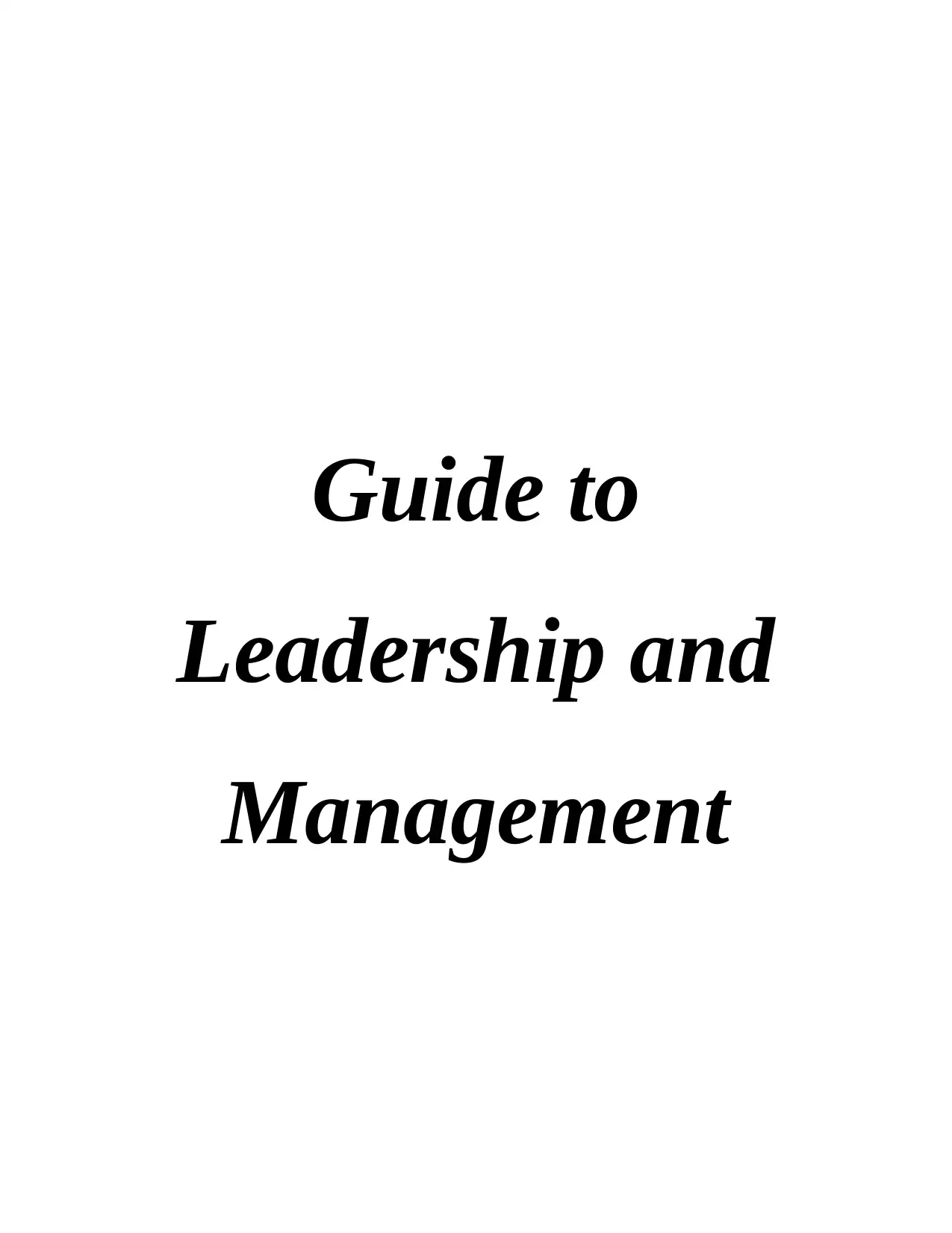
Guide to
Leadership and
Management
Leadership and
Management
Paraphrase This Document
Need a fresh take? Get an instant paraphrase of this document with our AI Paraphraser
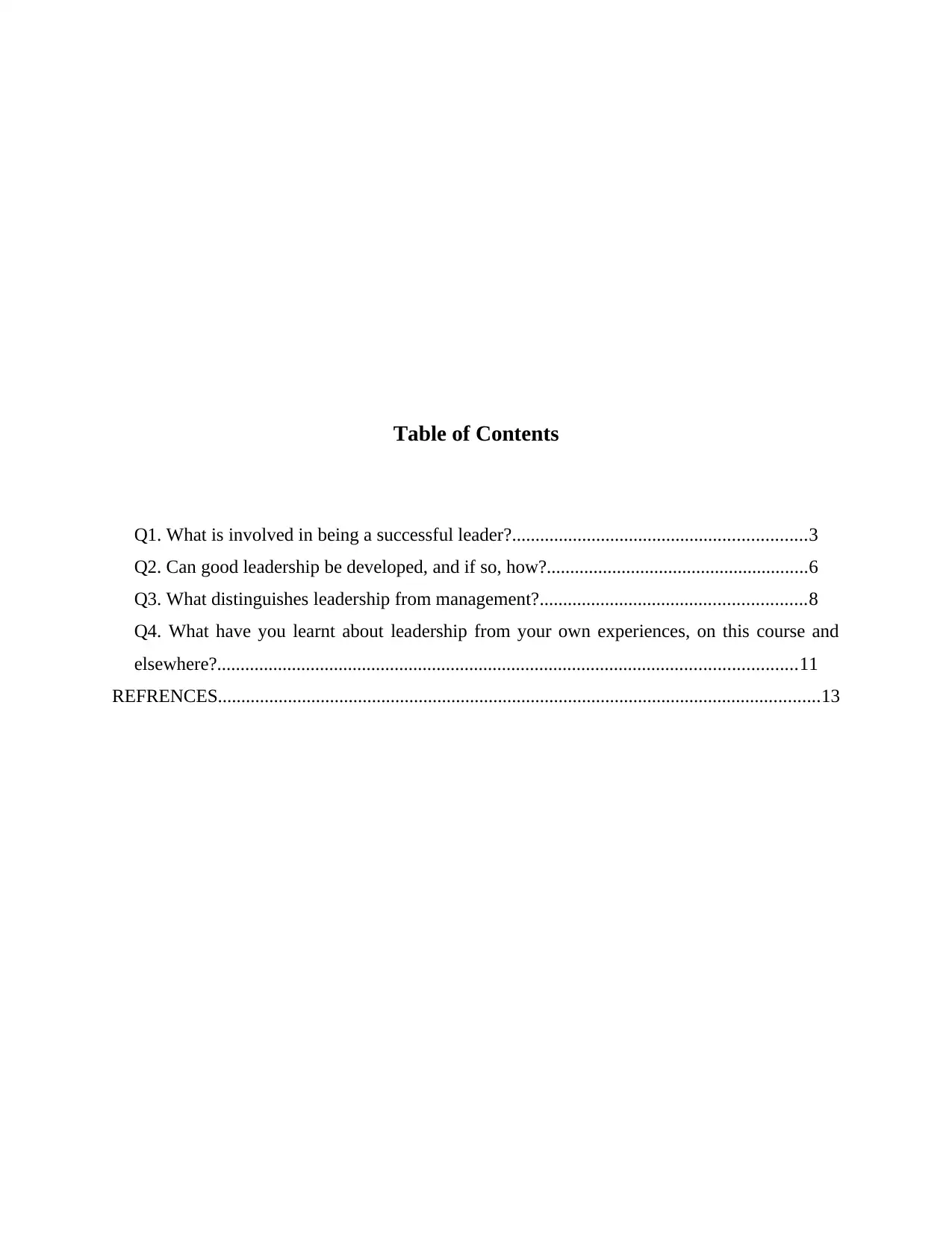
Table of Contents
Q1. What is involved in being a successful leader?...............................................................3
Q2. Can good leadership be developed, and if so, how?........................................................6
Q3. What distinguishes leadership from management?.........................................................8
Q4. What have you learnt about leadership from your own experiences, on this course and
elsewhere?............................................................................................................................11
REFRENCES.................................................................................................................................13
Q1. What is involved in being a successful leader?...............................................................3
Q2. Can good leadership be developed, and if so, how?........................................................6
Q3. What distinguishes leadership from management?.........................................................8
Q4. What have you learnt about leadership from your own experiences, on this course and
elsewhere?............................................................................................................................11
REFRENCES.................................................................................................................................13

Q1. What is involved in being a successful leader?
Leader is the person who influence individual or group of people for accomplishing
particular goals and objectives. Activities performed by leader is leadership which provide
direction for organisation as well as employees (Chang, 2016). Along with this, a successful
leader have several traits, skills and style which help them in accomplishing goals as well as
objectives.
Big Five personality traits – There are mainly five big personality traits that an leader
use for assisting their employees. All these dimensions will work as an personality traits in
making up individual as well as also in developing their skills and knowledge. This big five
personality traits are also known as OCEAN model. Discussion are as follows :-
Openness Leaders who trusts in learning new just as appreciate new experience for
the most part score high in receptiveness. It incorporate characteristics, for
example, being smart, inventive and have wide scope of intrigue. All these
will help in getting pioneer fruitful and achieving objectives of
organization.
Conscientiousness Leaders who are scrupulous incorporate characteristics, for example, sort
out, methodic and exhaustive. Person who have high level of uprightness
are dependable and brief. For getting fruitful as pioneer and achieving
objectives of separate association in successful way this quality is required.
Extraversion They are the person who get vitality while communicating from others and
extraversion pioneers have qualities, for example, fiery, loquacious and
self-assured. Such leaders can without much of a stretch impact other staff
individuals from Millstone lodging and result in picking up progress.
Agreeableness leaders with appropriateness are agreeable, cordial and empathetic in
nature. Essentially qualities are benevolent, warm just as thoughtful.
Pioneer of achievement Hotel can without much of a stretch make cordial
workplace inside association and help in picking up progress.
Neuroticism It is otherwise called enthusiastic dependability just as neuroticism
measurement is identified with passionate steadiness and level of negative
feelings. Qualities included are grouchy and tense. Their is no necessity of
Leader is the person who influence individual or group of people for accomplishing
particular goals and objectives. Activities performed by leader is leadership which provide
direction for organisation as well as employees (Chang, 2016). Along with this, a successful
leader have several traits, skills and style which help them in accomplishing goals as well as
objectives.
Big Five personality traits – There are mainly five big personality traits that an leader
use for assisting their employees. All these dimensions will work as an personality traits in
making up individual as well as also in developing their skills and knowledge. This big five
personality traits are also known as OCEAN model. Discussion are as follows :-
Openness Leaders who trusts in learning new just as appreciate new experience for
the most part score high in receptiveness. It incorporate characteristics, for
example, being smart, inventive and have wide scope of intrigue. All these
will help in getting pioneer fruitful and achieving objectives of
organization.
Conscientiousness Leaders who are scrupulous incorporate characteristics, for example, sort
out, methodic and exhaustive. Person who have high level of uprightness
are dependable and brief. For getting fruitful as pioneer and achieving
objectives of separate association in successful way this quality is required.
Extraversion They are the person who get vitality while communicating from others and
extraversion pioneers have qualities, for example, fiery, loquacious and
self-assured. Such leaders can without much of a stretch impact other staff
individuals from Millstone lodging and result in picking up progress.
Agreeableness leaders with appropriateness are agreeable, cordial and empathetic in
nature. Essentially qualities are benevolent, warm just as thoughtful.
Pioneer of achievement Hotel can without much of a stretch make cordial
workplace inside association and help in picking up progress.
Neuroticism It is otherwise called enthusiastic dependability just as neuroticism
measurement is identified with passionate steadiness and level of negative
feelings. Qualities included are grouchy and tense. Their is no necessity of
⊘ This is a preview!⊘
Do you want full access?
Subscribe today to unlock all pages.

Trusted by 1+ million students worldwide
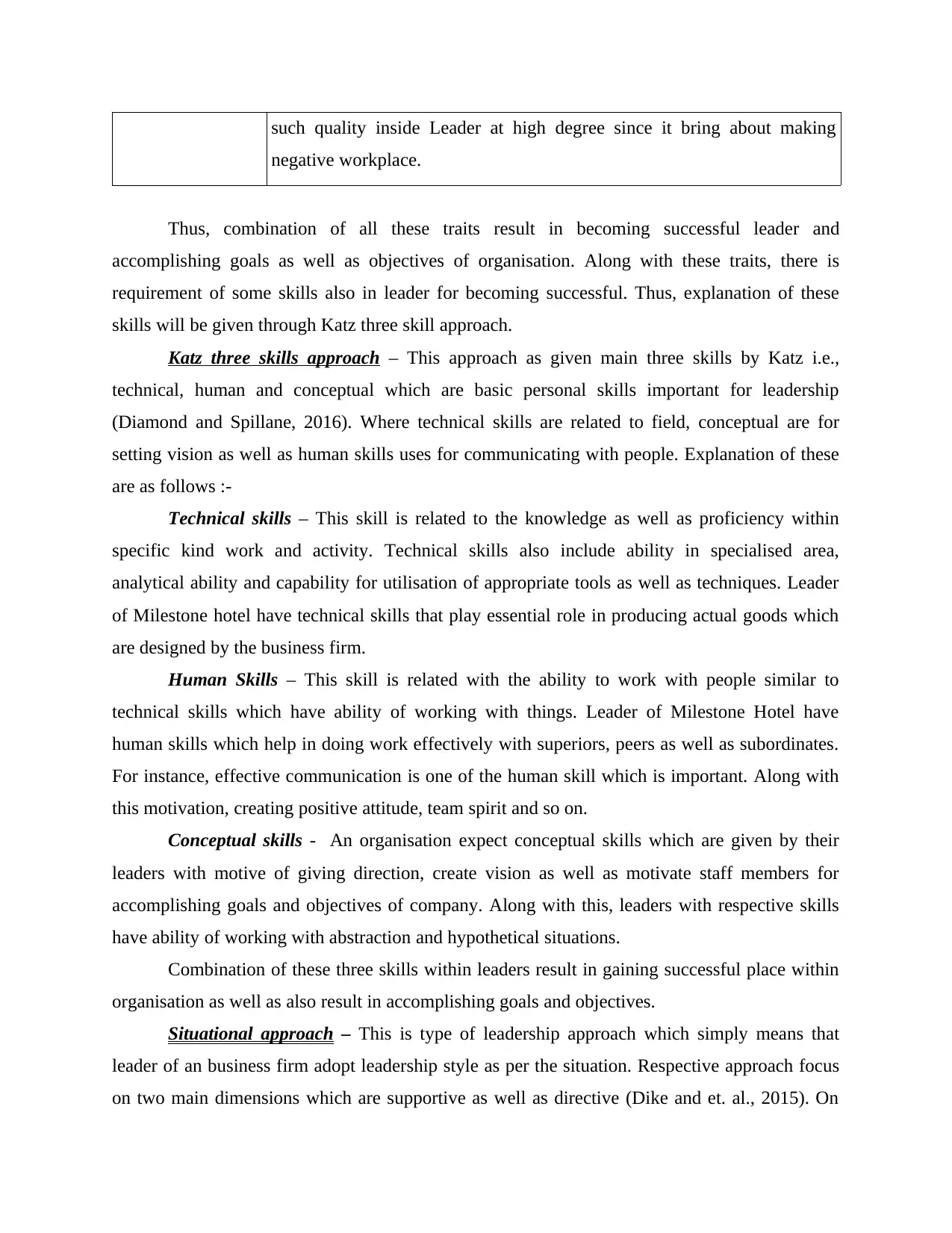
such quality inside Leader at high degree since it bring about making
negative workplace.
Thus, combination of all these traits result in becoming successful leader and
accomplishing goals as well as objectives of organisation. Along with these traits, there is
requirement of some skills also in leader for becoming successful. Thus, explanation of these
skills will be given through Katz three skill approach.
Katz three skills approach – This approach as given main three skills by Katz i.e.,
technical, human and conceptual which are basic personal skills important for leadership
(Diamond and Spillane, 2016). Where technical skills are related to field, conceptual are for
setting vision as well as human skills uses for communicating with people. Explanation of these
are as follows :-
Technical skills – This skill is related to the knowledge as well as proficiency within
specific kind work and activity. Technical skills also include ability in specialised area,
analytical ability and capability for utilisation of appropriate tools as well as techniques. Leader
of Milestone hotel have technical skills that play essential role in producing actual goods which
are designed by the business firm.
Human Skills – This skill is related with the ability to work with people similar to
technical skills which have ability of working with things. Leader of Milestone Hotel have
human skills which help in doing work effectively with superiors, peers as well as subordinates.
For instance, effective communication is one of the human skill which is important. Along with
this motivation, creating positive attitude, team spirit and so on.
Conceptual skills - An organisation expect conceptual skills which are given by their
leaders with motive of giving direction, create vision as well as motivate staff members for
accomplishing goals and objectives of company. Along with this, leaders with respective skills
have ability of working with abstraction and hypothetical situations.
Combination of these three skills within leaders result in gaining successful place within
organisation as well as also result in accomplishing goals and objectives.
Situational approach – This is type of leadership approach which simply means that
leader of an business firm adopt leadership style as per the situation. Respective approach focus
on two main dimensions which are supportive as well as directive (Dike and et. al., 2015). On
negative workplace.
Thus, combination of all these traits result in becoming successful leader and
accomplishing goals as well as objectives of organisation. Along with these traits, there is
requirement of some skills also in leader for becoming successful. Thus, explanation of these
skills will be given through Katz three skill approach.
Katz three skills approach – This approach as given main three skills by Katz i.e.,
technical, human and conceptual which are basic personal skills important for leadership
(Diamond and Spillane, 2016). Where technical skills are related to field, conceptual are for
setting vision as well as human skills uses for communicating with people. Explanation of these
are as follows :-
Technical skills – This skill is related to the knowledge as well as proficiency within
specific kind work and activity. Technical skills also include ability in specialised area,
analytical ability and capability for utilisation of appropriate tools as well as techniques. Leader
of Milestone hotel have technical skills that play essential role in producing actual goods which
are designed by the business firm.
Human Skills – This skill is related with the ability to work with people similar to
technical skills which have ability of working with things. Leader of Milestone Hotel have
human skills which help in doing work effectively with superiors, peers as well as subordinates.
For instance, effective communication is one of the human skill which is important. Along with
this motivation, creating positive attitude, team spirit and so on.
Conceptual skills - An organisation expect conceptual skills which are given by their
leaders with motive of giving direction, create vision as well as motivate staff members for
accomplishing goals and objectives of company. Along with this, leaders with respective skills
have ability of working with abstraction and hypothetical situations.
Combination of these three skills within leaders result in gaining successful place within
organisation as well as also result in accomplishing goals and objectives.
Situational approach – This is type of leadership approach which simply means that
leader of an business firm adopt leadership style as per the situation. Respective approach focus
on two main dimensions which are supportive as well as directive (Dike and et. al., 2015). On
Paraphrase This Document
Need a fresh take? Get an instant paraphrase of this document with our AI Paraphraser

the basis of dimensions guidance has been provided to subordinates by their leaders. Situational
approach is practical and style will implement as per the developed situation. In this approach the
leader invites the problem, get suggestion from their employees and make effective decision.
A leader must adapt style according to the situation such as task, nature of group, factors
contributing for getting a job done. A leader need to deal the situation with maturity so that
leader can measure the competent and commitment of employees towards their work.
Transformational leadership - It can be defined as a leadership which is friendly, open-
minded, cared about emotions of their employees, provide them familiar environment, motivates
them to work harder and smarter to achieve organisational goals. In these kind of leadership,
leader has long-term vision and with the help of creative and innovative ideas make their
decisions more effective. With the use of transformational leadership the organisation will retain
its talented and skilled employees (Ejimabo, 2015). The transformational leaders are the lifelong
learners and gain knowledge which help them to adjust themselves according the dynamic
environment. Transformational leaders set an example for their subordinates by creating
environment of trust and respect through transparency. The leaders appreciate their employees
by providing them incentives, bonus, benefits etc. For instance, Nelson Rolihlahla Mandela
follow transformational leadership style which help them in dealing with situation in friendly
manner, open minded and he also care about the emotions of employees working with him.
A leader must create friendly relations with their subordinates so that they can feel free to
share their problems which they are facing within and outside the company. A leader must allow
their employees to share their ideas, opinions while making a decision and think beyond
organisational plans and policies (English, 2015).
Inspirational Leadership – It is all about creating as well as energizing sense of direction
and purpose for staff members. In simple term it can be said that inspirational leader are those
who adopt several styles of leadership which are totally depended on the situation. It is all about
using right method for handling situation at right time as well as also considering motivation into
account for those who are leading. For instance, Nelson Rolihlahla Mandela is the leader who
follow inspirational leadership style for guiding people in effective manner.
A leader following this leadership style will help them to build relationship with their
employees and gain their trust. The leader must guide them instead of giving commands,
approach is practical and style will implement as per the developed situation. In this approach the
leader invites the problem, get suggestion from their employees and make effective decision.
A leader must adapt style according to the situation such as task, nature of group, factors
contributing for getting a job done. A leader need to deal the situation with maturity so that
leader can measure the competent and commitment of employees towards their work.
Transformational leadership - It can be defined as a leadership which is friendly, open-
minded, cared about emotions of their employees, provide them familiar environment, motivates
them to work harder and smarter to achieve organisational goals. In these kind of leadership,
leader has long-term vision and with the help of creative and innovative ideas make their
decisions more effective. With the use of transformational leadership the organisation will retain
its talented and skilled employees (Ejimabo, 2015). The transformational leaders are the lifelong
learners and gain knowledge which help them to adjust themselves according the dynamic
environment. Transformational leaders set an example for their subordinates by creating
environment of trust and respect through transparency. The leaders appreciate their employees
by providing them incentives, bonus, benefits etc. For instance, Nelson Rolihlahla Mandela
follow transformational leadership style which help them in dealing with situation in friendly
manner, open minded and he also care about the emotions of employees working with him.
A leader must create friendly relations with their subordinates so that they can feel free to
share their problems which they are facing within and outside the company. A leader must allow
their employees to share their ideas, opinions while making a decision and think beyond
organisational plans and policies (English, 2015).
Inspirational Leadership – It is all about creating as well as energizing sense of direction
and purpose for staff members. In simple term it can be said that inspirational leader are those
who adopt several styles of leadership which are totally depended on the situation. It is all about
using right method for handling situation at right time as well as also considering motivation into
account for those who are leading. For instance, Nelson Rolihlahla Mandela is the leader who
follow inspirational leadership style for guiding people in effective manner.
A leader following this leadership style will help them to build relationship with their
employees and gain their trust. The leader must guide them instead of giving commands,
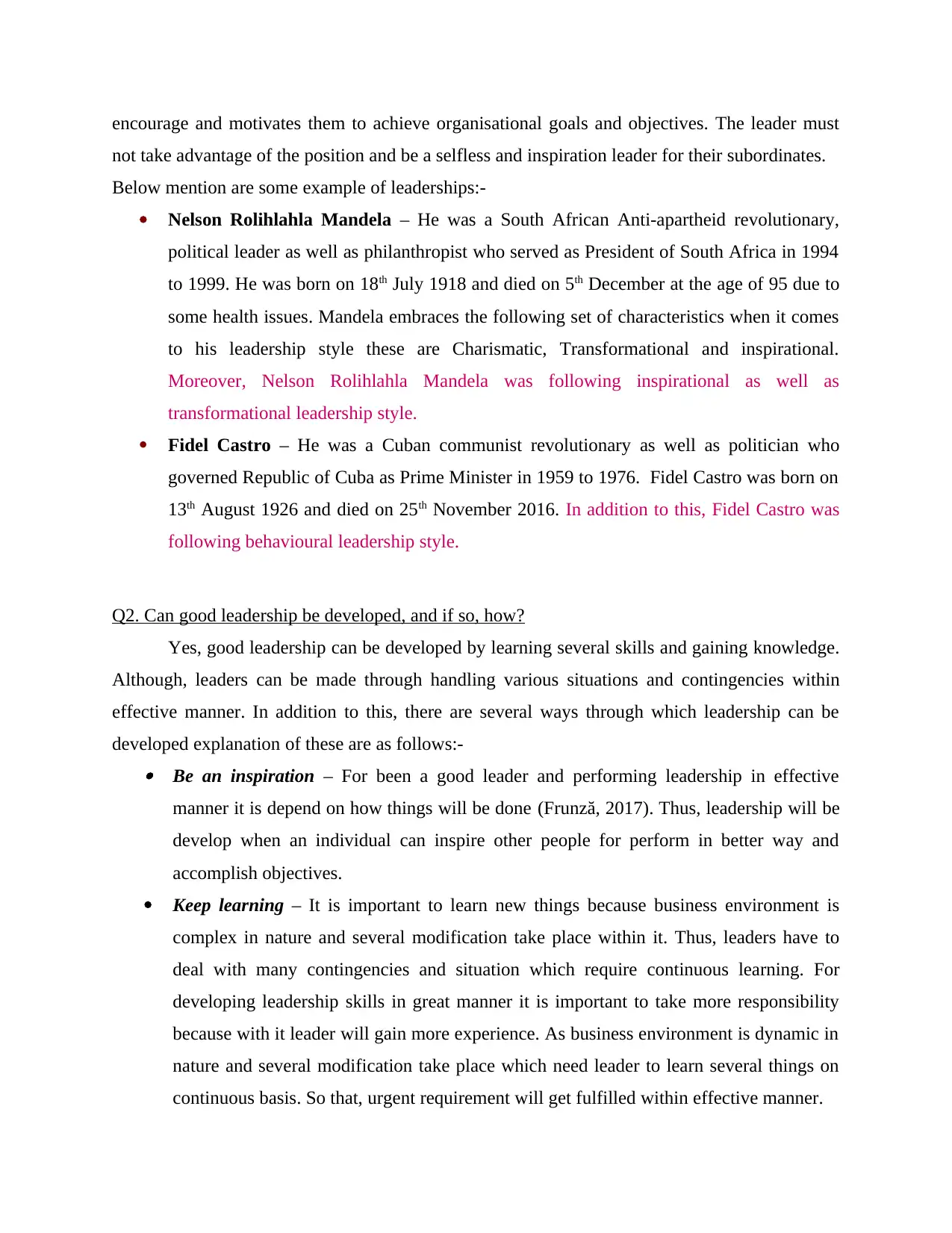
encourage and motivates them to achieve organisational goals and objectives. The leader must
not take advantage of the position and be a selfless and inspiration leader for their subordinates.
Below mention are some example of leaderships:-
Nelson Rolihlahla Mandela – He was a South African Anti-apartheid revolutionary,
political leader as well as philanthropist who served as President of South Africa in 1994
to 1999. He was born on 18th July 1918 and died on 5th December at the age of 95 due to
some health issues. Mandela embraces the following set of characteristics when it comes
to his leadership style these are Charismatic, Transformational and inspirational.
Moreover, Nelson Rolihlahla Mandela was following inspirational as well as
transformational leadership style.
Fidel Castro – He was a Cuban communist revolutionary as well as politician who
governed Republic of Cuba as Prime Minister in 1959 to 1976. Fidel Castro was born on
13th August 1926 and died on 25th November 2016. In addition to this, Fidel Castro was
following behavioural leadership style.
Q2. Can good leadership be developed, and if so, how?
Yes, good leadership can be developed by learning several skills and gaining knowledge.
Although, leaders can be made through handling various situations and contingencies within
effective manner. In addition to this, there are several ways through which leadership can be
developed explanation of these are as follows:- Be an inspiration – For been a good leader and performing leadership in effective
manner it is depend on how things will be done (Frunză, 2017). Thus, leadership will be
develop when an individual can inspire other people for perform in better way and
accomplish objectives.
Keep learning – It is important to learn new things because business environment is
complex in nature and several modification take place within it. Thus, leaders have to
deal with many contingencies and situation which require continuous learning. For
developing leadership skills in great manner it is important to take more responsibility
because with it leader will gain more experience. As business environment is dynamic in
nature and several modification take place which need leader to learn several things on
continuous basis. So that, urgent requirement will get fulfilled within effective manner.
not take advantage of the position and be a selfless and inspiration leader for their subordinates.
Below mention are some example of leaderships:-
Nelson Rolihlahla Mandela – He was a South African Anti-apartheid revolutionary,
political leader as well as philanthropist who served as President of South Africa in 1994
to 1999. He was born on 18th July 1918 and died on 5th December at the age of 95 due to
some health issues. Mandela embraces the following set of characteristics when it comes
to his leadership style these are Charismatic, Transformational and inspirational.
Moreover, Nelson Rolihlahla Mandela was following inspirational as well as
transformational leadership style.
Fidel Castro – He was a Cuban communist revolutionary as well as politician who
governed Republic of Cuba as Prime Minister in 1959 to 1976. Fidel Castro was born on
13th August 1926 and died on 25th November 2016. In addition to this, Fidel Castro was
following behavioural leadership style.
Q2. Can good leadership be developed, and if so, how?
Yes, good leadership can be developed by learning several skills and gaining knowledge.
Although, leaders can be made through handling various situations and contingencies within
effective manner. In addition to this, there are several ways through which leadership can be
developed explanation of these are as follows:- Be an inspiration – For been a good leader and performing leadership in effective
manner it is depend on how things will be done (Frunză, 2017). Thus, leadership will be
develop when an individual can inspire other people for perform in better way and
accomplish objectives.
Keep learning – It is important to learn new things because business environment is
complex in nature and several modification take place within it. Thus, leaders have to
deal with many contingencies and situation which require continuous learning. For
developing leadership skills in great manner it is important to take more responsibility
because with it leader will gain more experience. As business environment is dynamic in
nature and several modification take place which need leader to learn several things on
continuous basis. So that, urgent requirement will get fulfilled within effective manner.
⊘ This is a preview!⊘
Do you want full access?
Subscribe today to unlock all pages.

Trusted by 1+ million students worldwide
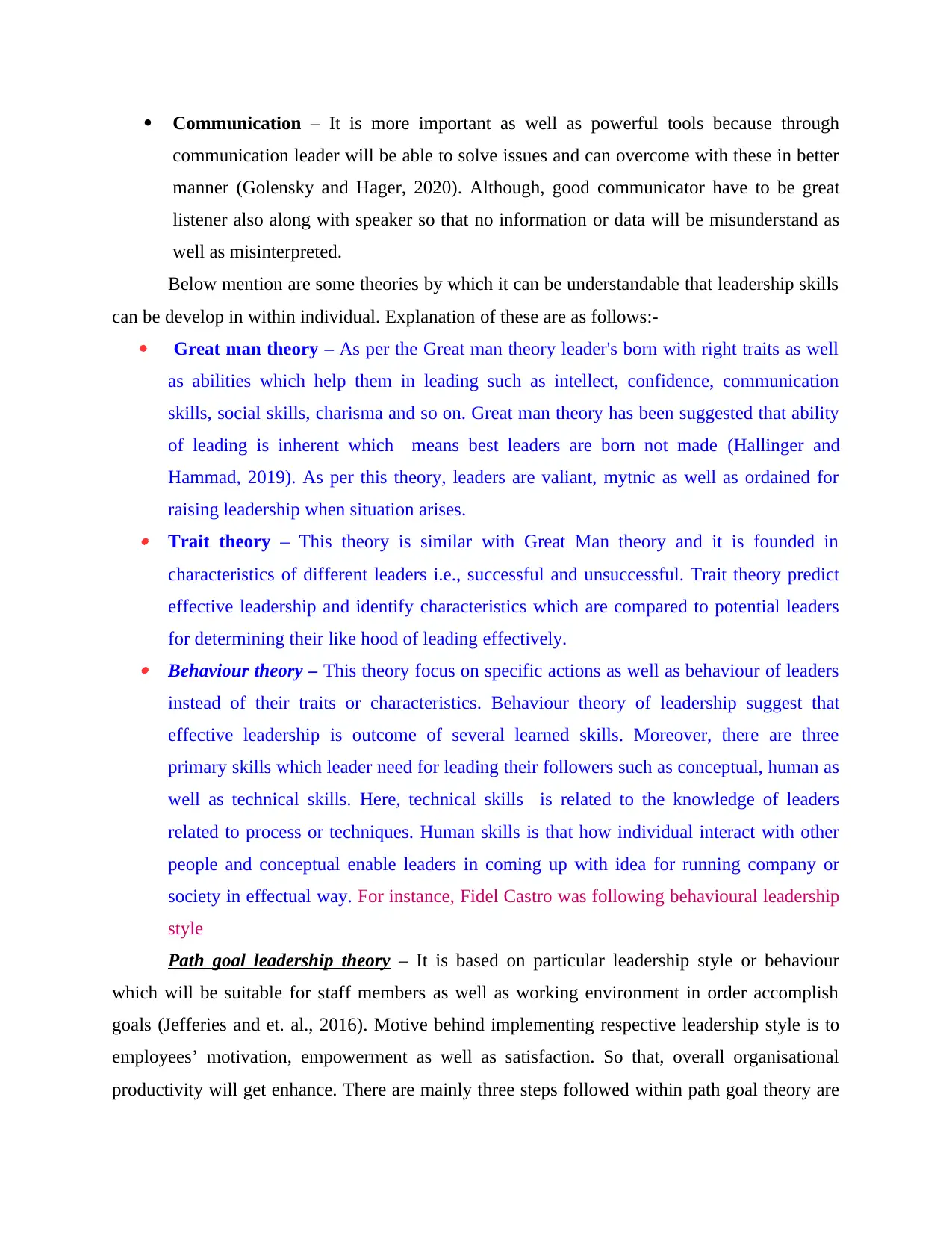
Communication – It is more important as well as powerful tools because through
communication leader will be able to solve issues and can overcome with these in better
manner (Golensky and Hager, 2020). Although, good communicator have to be great
listener also along with speaker so that no information or data will be misunderstand as
well as misinterpreted.
Below mention are some theories by which it can be understandable that leadership skills
can be develop in within individual. Explanation of these are as follows:-
Great man theory – As per the Great man theory leader's born with right traits as well
as abilities which help them in leading such as intellect, confidence, communication
skills, social skills, charisma and so on. Great man theory has been suggested that ability
of leading is inherent which means best leaders are born not made (Hallinger and
Hammad, 2019). As per this theory, leaders are valiant, mytnic as well as ordained for
raising leadership when situation arises. Trait theory – This theory is similar with Great Man theory and it is founded in
characteristics of different leaders i.e., successful and unsuccessful. Trait theory predict
effective leadership and identify characteristics which are compared to potential leaders
for determining their like hood of leading effectively. Behaviour theory – This theory focus on specific actions as well as behaviour of leaders
instead of their traits or characteristics. Behaviour theory of leadership suggest that
effective leadership is outcome of several learned skills. Moreover, there are three
primary skills which leader need for leading their followers such as conceptual, human as
well as technical skills. Here, technical skills is related to the knowledge of leaders
related to process or techniques. Human skills is that how individual interact with other
people and conceptual enable leaders in coming up with idea for running company or
society in effectual way. For instance, Fidel Castro was following behavioural leadership
style
Path goal leadership theory – It is based on particular leadership style or behaviour
which will be suitable for staff members as well as working environment in order accomplish
goals (Jefferies and et. al., 2016). Motive behind implementing respective leadership style is to
employees’ motivation, empowerment as well as satisfaction. So that, overall organisational
productivity will get enhance. There are mainly three steps followed within path goal theory are
communication leader will be able to solve issues and can overcome with these in better
manner (Golensky and Hager, 2020). Although, good communicator have to be great
listener also along with speaker so that no information or data will be misunderstand as
well as misinterpreted.
Below mention are some theories by which it can be understandable that leadership skills
can be develop in within individual. Explanation of these are as follows:-
Great man theory – As per the Great man theory leader's born with right traits as well
as abilities which help them in leading such as intellect, confidence, communication
skills, social skills, charisma and so on. Great man theory has been suggested that ability
of leading is inherent which means best leaders are born not made (Hallinger and
Hammad, 2019). As per this theory, leaders are valiant, mytnic as well as ordained for
raising leadership when situation arises. Trait theory – This theory is similar with Great Man theory and it is founded in
characteristics of different leaders i.e., successful and unsuccessful. Trait theory predict
effective leadership and identify characteristics which are compared to potential leaders
for determining their like hood of leading effectively. Behaviour theory – This theory focus on specific actions as well as behaviour of leaders
instead of their traits or characteristics. Behaviour theory of leadership suggest that
effective leadership is outcome of several learned skills. Moreover, there are three
primary skills which leader need for leading their followers such as conceptual, human as
well as technical skills. Here, technical skills is related to the knowledge of leaders
related to process or techniques. Human skills is that how individual interact with other
people and conceptual enable leaders in coming up with idea for running company or
society in effectual way. For instance, Fidel Castro was following behavioural leadership
style
Path goal leadership theory – It is based on particular leadership style or behaviour
which will be suitable for staff members as well as working environment in order accomplish
goals (Jefferies and et. al., 2016). Motive behind implementing respective leadership style is to
employees’ motivation, empowerment as well as satisfaction. So that, overall organisational
productivity will get enhance. There are mainly three steps followed within path goal theory are
Paraphrase This Document
Need a fresh take? Get an instant paraphrase of this document with our AI Paraphraser
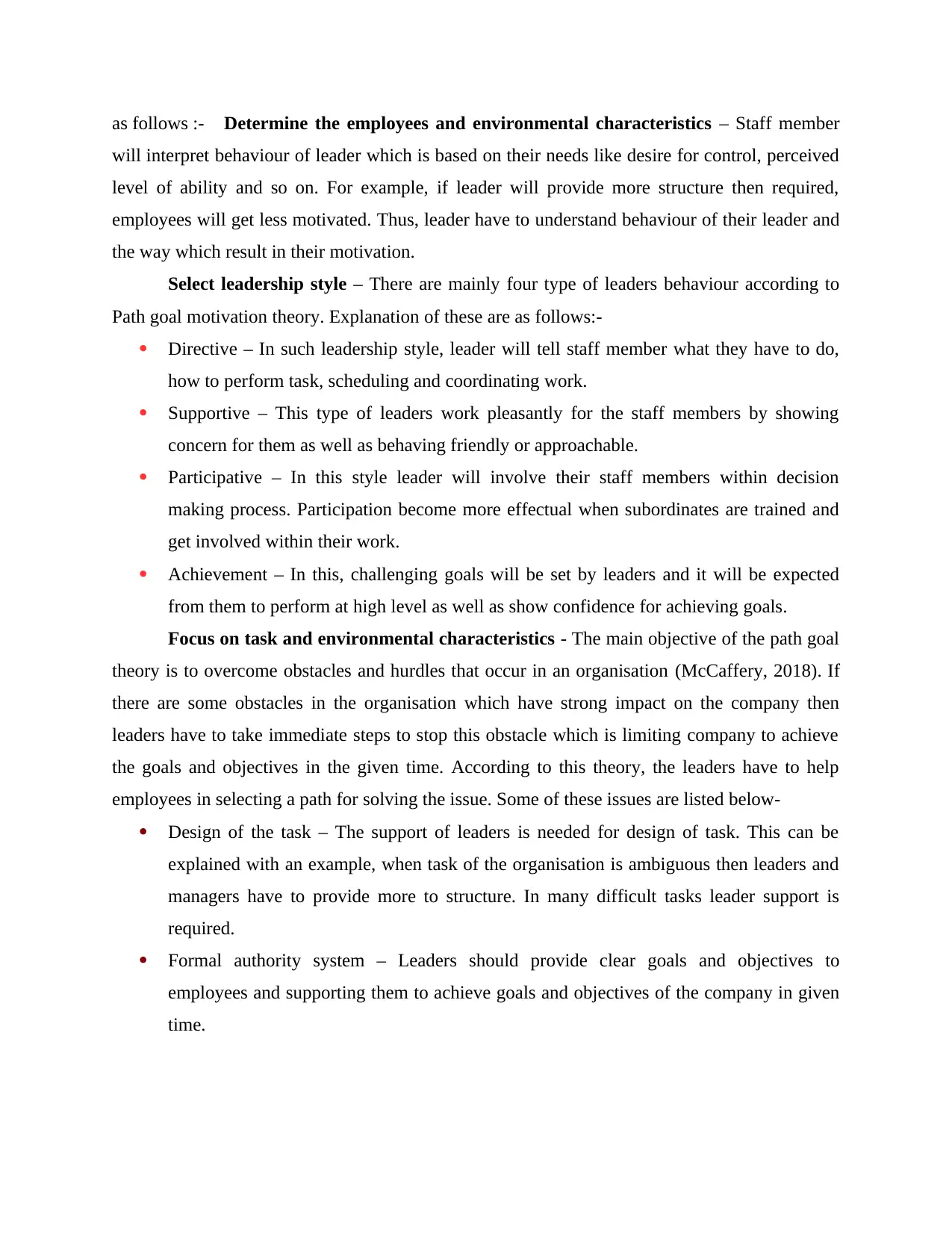
as follows :- Determine the employees and environmental characteristics – Staff member
will interpret behaviour of leader which is based on their needs like desire for control, perceived
level of ability and so on. For example, if leader will provide more structure then required,
employees will get less motivated. Thus, leader have to understand behaviour of their leader and
the way which result in their motivation.
Select leadership style – There are mainly four type of leaders behaviour according to
Path goal motivation theory. Explanation of these are as follows:-
Directive – In such leadership style, leader will tell staff member what they have to do,
how to perform task, scheduling and coordinating work.
Supportive – This type of leaders work pleasantly for the staff members by showing
concern for them as well as behaving friendly or approachable.
Participative – In this style leader will involve their staff members within decision
making process. Participation become more effectual when subordinates are trained and
get involved within their work.
Achievement – In this, challenging goals will be set by leaders and it will be expected
from them to perform at high level as well as show confidence for achieving goals.
Focus on task and environmental characteristics - The main objective of the path goal
theory is to overcome obstacles and hurdles that occur in an organisation (McCaffery, 2018). If
there are some obstacles in the organisation which have strong impact on the company then
leaders have to take immediate steps to stop this obstacle which is limiting company to achieve
the goals and objectives in the given time. According to this theory, the leaders have to help
employees in selecting a path for solving the issue. Some of these issues are listed below-
Design of the task – The support of leaders is needed for design of task. This can be
explained with an example, when task of the organisation is ambiguous then leaders and
managers have to provide more to structure. In many difficult tasks leader support is
required.
Formal authority system – Leaders should provide clear goals and objectives to
employees and supporting them to achieve goals and objectives of the company in given
time.
will interpret behaviour of leader which is based on their needs like desire for control, perceived
level of ability and so on. For example, if leader will provide more structure then required,
employees will get less motivated. Thus, leader have to understand behaviour of their leader and
the way which result in their motivation.
Select leadership style – There are mainly four type of leaders behaviour according to
Path goal motivation theory. Explanation of these are as follows:-
Directive – In such leadership style, leader will tell staff member what they have to do,
how to perform task, scheduling and coordinating work.
Supportive – This type of leaders work pleasantly for the staff members by showing
concern for them as well as behaving friendly or approachable.
Participative – In this style leader will involve their staff members within decision
making process. Participation become more effectual when subordinates are trained and
get involved within their work.
Achievement – In this, challenging goals will be set by leaders and it will be expected
from them to perform at high level as well as show confidence for achieving goals.
Focus on task and environmental characteristics - The main objective of the path goal
theory is to overcome obstacles and hurdles that occur in an organisation (McCaffery, 2018). If
there are some obstacles in the organisation which have strong impact on the company then
leaders have to take immediate steps to stop this obstacle which is limiting company to achieve
the goals and objectives in the given time. According to this theory, the leaders have to help
employees in selecting a path for solving the issue. Some of these issues are listed below-
Design of the task – The support of leaders is needed for design of task. This can be
explained with an example, when task of the organisation is ambiguous then leaders and
managers have to provide more to structure. In many difficult tasks leader support is
required.
Formal authority system – Leaders should provide clear goals and objectives to
employees and supporting them to achieve goals and objectives of the company in given
time.
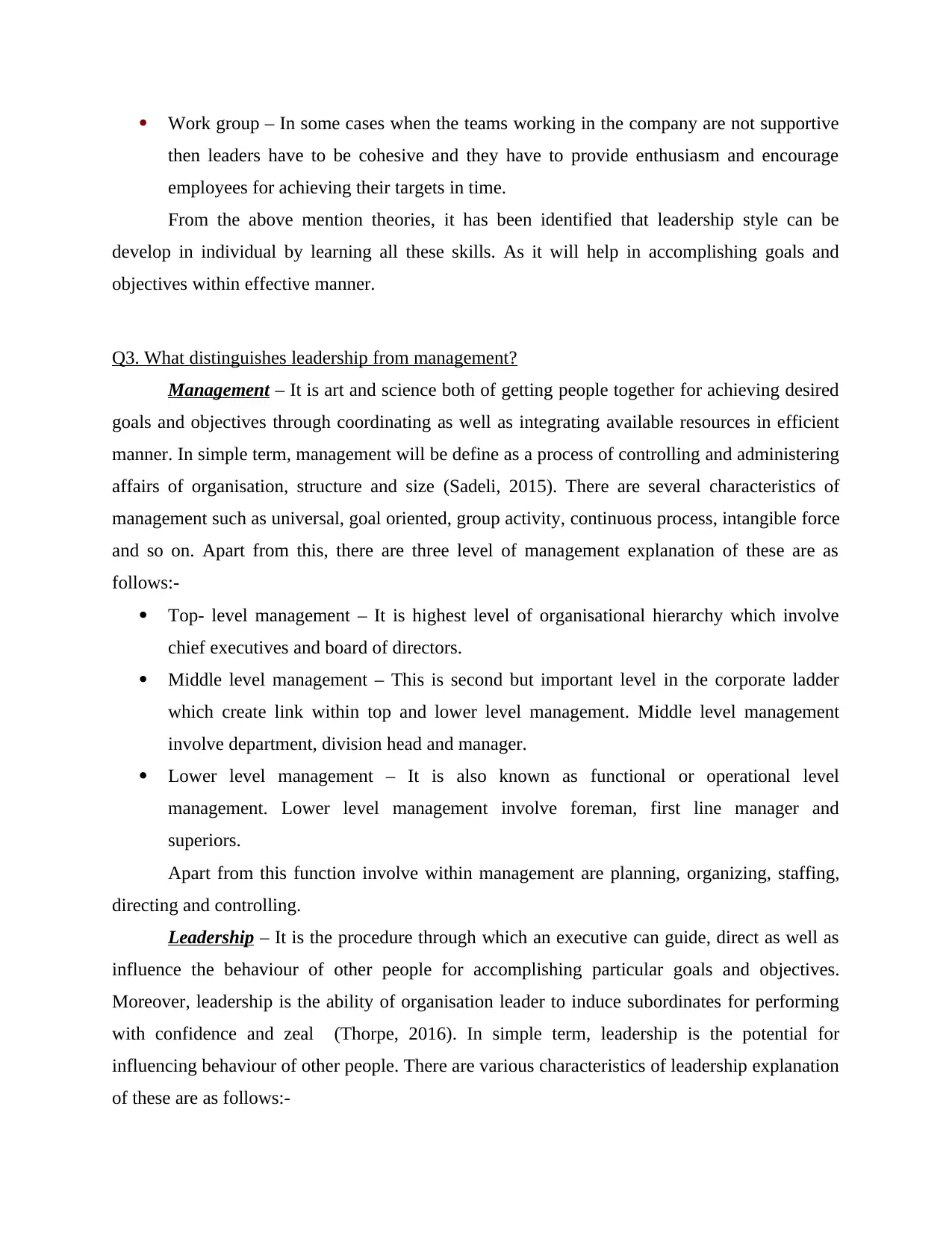
Work group – In some cases when the teams working in the company are not supportive
then leaders have to be cohesive and they have to provide enthusiasm and encourage
employees for achieving their targets in time.
From the above mention theories, it has been identified that leadership style can be
develop in individual by learning all these skills. As it will help in accomplishing goals and
objectives within effective manner.
Q3. What distinguishes leadership from management?
Management – It is art and science both of getting people together for achieving desired
goals and objectives through coordinating as well as integrating available resources in efficient
manner. In simple term, management will be define as a process of controlling and administering
affairs of organisation, structure and size (Sadeli, 2015). There are several characteristics of
management such as universal, goal oriented, group activity, continuous process, intangible force
and so on. Apart from this, there are three level of management explanation of these are as
follows:-
Top- level management – It is highest level of organisational hierarchy which involve
chief executives and board of directors.
Middle level management – This is second but important level in the corporate ladder
which create link within top and lower level management. Middle level management
involve department, division head and manager.
Lower level management – It is also known as functional or operational level
management. Lower level management involve foreman, first line manager and
superiors.
Apart from this function involve within management are planning, organizing, staffing,
directing and controlling.
Leadership – It is the procedure through which an executive can guide, direct as well as
influence the behaviour of other people for accomplishing particular goals and objectives.
Moreover, leadership is the ability of organisation leader to induce subordinates for performing
with confidence and zeal (Thorpe, 2016). In simple term, leadership is the potential for
influencing behaviour of other people. There are various characteristics of leadership explanation
of these are as follows:-
then leaders have to be cohesive and they have to provide enthusiasm and encourage
employees for achieving their targets in time.
From the above mention theories, it has been identified that leadership style can be
develop in individual by learning all these skills. As it will help in accomplishing goals and
objectives within effective manner.
Q3. What distinguishes leadership from management?
Management – It is art and science both of getting people together for achieving desired
goals and objectives through coordinating as well as integrating available resources in efficient
manner. In simple term, management will be define as a process of controlling and administering
affairs of organisation, structure and size (Sadeli, 2015). There are several characteristics of
management such as universal, goal oriented, group activity, continuous process, intangible force
and so on. Apart from this, there are three level of management explanation of these are as
follows:-
Top- level management – It is highest level of organisational hierarchy which involve
chief executives and board of directors.
Middle level management – This is second but important level in the corporate ladder
which create link within top and lower level management. Middle level management
involve department, division head and manager.
Lower level management – It is also known as functional or operational level
management. Lower level management involve foreman, first line manager and
superiors.
Apart from this function involve within management are planning, organizing, staffing,
directing and controlling.
Leadership – It is the procedure through which an executive can guide, direct as well as
influence the behaviour of other people for accomplishing particular goals and objectives.
Moreover, leadership is the ability of organisation leader to induce subordinates for performing
with confidence and zeal (Thorpe, 2016). In simple term, leadership is the potential for
influencing behaviour of other people. There are various characteristics of leadership explanation
of these are as follows:-
⊘ This is a preview!⊘
Do you want full access?
Subscribe today to unlock all pages.

Trusted by 1+ million students worldwide
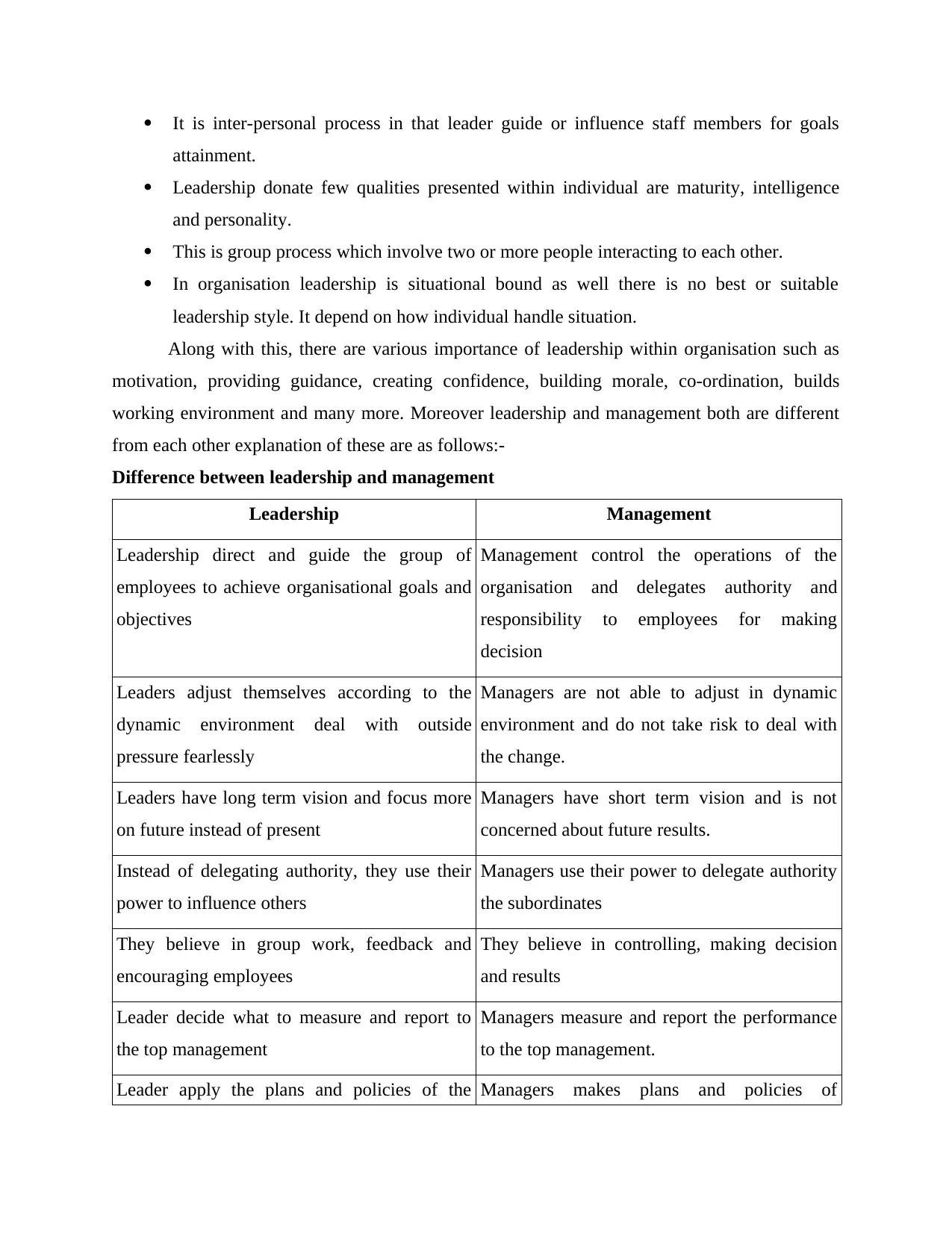
It is inter-personal process in that leader guide or influence staff members for goals
attainment.
Leadership donate few qualities presented within individual are maturity, intelligence
and personality.
This is group process which involve two or more people interacting to each other.
In organisation leadership is situational bound as well there is no best or suitable
leadership style. It depend on how individual handle situation.
Along with this, there are various importance of leadership within organisation such as
motivation, providing guidance, creating confidence, building morale, co-ordination, builds
working environment and many more. Moreover leadership and management both are different
from each other explanation of these are as follows:-
Difference between leadership and management
Leadership Management
Leadership direct and guide the group of
employees to achieve organisational goals and
objectives
Management control the operations of the
organisation and delegates authority and
responsibility to employees for making
decision
Leaders adjust themselves according to the
dynamic environment deal with outside
pressure fearlessly
Managers are not able to adjust in dynamic
environment and do not take risk to deal with
the change.
Leaders have long term vision and focus more
on future instead of present
Managers have short term vision and is not
concerned about future results.
Instead of delegating authority, they use their
power to influence others
Managers use their power to delegate authority
the subordinates
They believe in group work, feedback and
encouraging employees
They believe in controlling, making decision
and results
Leader decide what to measure and report to
the top management
Managers measure and report the performance
to the top management.
Leader apply the plans and policies of the Managers makes plans and policies of
attainment.
Leadership donate few qualities presented within individual are maturity, intelligence
and personality.
This is group process which involve two or more people interacting to each other.
In organisation leadership is situational bound as well there is no best or suitable
leadership style. It depend on how individual handle situation.
Along with this, there are various importance of leadership within organisation such as
motivation, providing guidance, creating confidence, building morale, co-ordination, builds
working environment and many more. Moreover leadership and management both are different
from each other explanation of these are as follows:-
Difference between leadership and management
Leadership Management
Leadership direct and guide the group of
employees to achieve organisational goals and
objectives
Management control the operations of the
organisation and delegates authority and
responsibility to employees for making
decision
Leaders adjust themselves according to the
dynamic environment deal with outside
pressure fearlessly
Managers are not able to adjust in dynamic
environment and do not take risk to deal with
the change.
Leaders have long term vision and focus more
on future instead of present
Managers have short term vision and is not
concerned about future results.
Instead of delegating authority, they use their
power to influence others
Managers use their power to delegate authority
the subordinates
They believe in group work, feedback and
encouraging employees
They believe in controlling, making decision
and results
Leader decide what to measure and report to
the top management
Managers measure and report the performance
to the top management.
Leader apply the plans and policies of the Managers makes plans and policies of
Paraphrase This Document
Need a fresh take? Get an instant paraphrase of this document with our AI Paraphraser

organisation which is given by top level
management.
organisation and assign task to staff members.
They do not limit themselves to the
organisation structure, rules, plans and policies
They limit themselves to the organisation
structure, rules, plans and policies.
Leaders recruit talented and skilled employees
for accomplishing common goals.
Managers creates new jobs roles to attract
employees with the motive of achieving
organisational goals and objectives.
Leadership come up with unique ideas, views
and techniques to make their results productive
Managers tend to follow the traditional
techniques to achieve organisational goals
Leaders takes risk and embrace them for better
results. Motive behind risk taking is to
bringing something new and growth of
company as well as employees.
Managers control or avoid risk instead of
embracing them. Because their motive behind
this is not to harm organisation in monetary
form.
Leaders focus on the personal growth of the
employees and build relationship with them
Managers focus on organisation structure and
objective to be achieved as well as overall
growth of business.
To become a leader one doesn't need
experienced of years, they must have skills to
deal with the outside pressure
To become a manager one need a years of
experience to adjust according to organisation
structure.
Leaders behave friendly with team members as
well as solve their issues and provide them job
satisfaction.
Managers deals with the problems related to
task and project rather than providing job
satisfaction to particular staff member.
Q4. What have you learnt about leadership from your own experiences, on this course and
elsewhere?
My experience within workplace is very interested because as a leader, my manager is
very supportive as well as helpful in doing activities within an effective manner without any
mistakes. As leader he is using supportive leadership style which provides me support as well as
management.
organisation and assign task to staff members.
They do not limit themselves to the
organisation structure, rules, plans and policies
They limit themselves to the organisation
structure, rules, plans and policies.
Leaders recruit talented and skilled employees
for accomplishing common goals.
Managers creates new jobs roles to attract
employees with the motive of achieving
organisational goals and objectives.
Leadership come up with unique ideas, views
and techniques to make their results productive
Managers tend to follow the traditional
techniques to achieve organisational goals
Leaders takes risk and embrace them for better
results. Motive behind risk taking is to
bringing something new and growth of
company as well as employees.
Managers control or avoid risk instead of
embracing them. Because their motive behind
this is not to harm organisation in monetary
form.
Leaders focus on the personal growth of the
employees and build relationship with them
Managers focus on organisation structure and
objective to be achieved as well as overall
growth of business.
To become a leader one doesn't need
experienced of years, they must have skills to
deal with the outside pressure
To become a manager one need a years of
experience to adjust according to organisation
structure.
Leaders behave friendly with team members as
well as solve their issues and provide them job
satisfaction.
Managers deals with the problems related to
task and project rather than providing job
satisfaction to particular staff member.
Q4. What have you learnt about leadership from your own experiences, on this course and
elsewhere?
My experience within workplace is very interested because as a leader, my manager is
very supportive as well as helpful in doing activities within an effective manner without any
mistakes. As leader he is using supportive leadership style which provides me support as well as
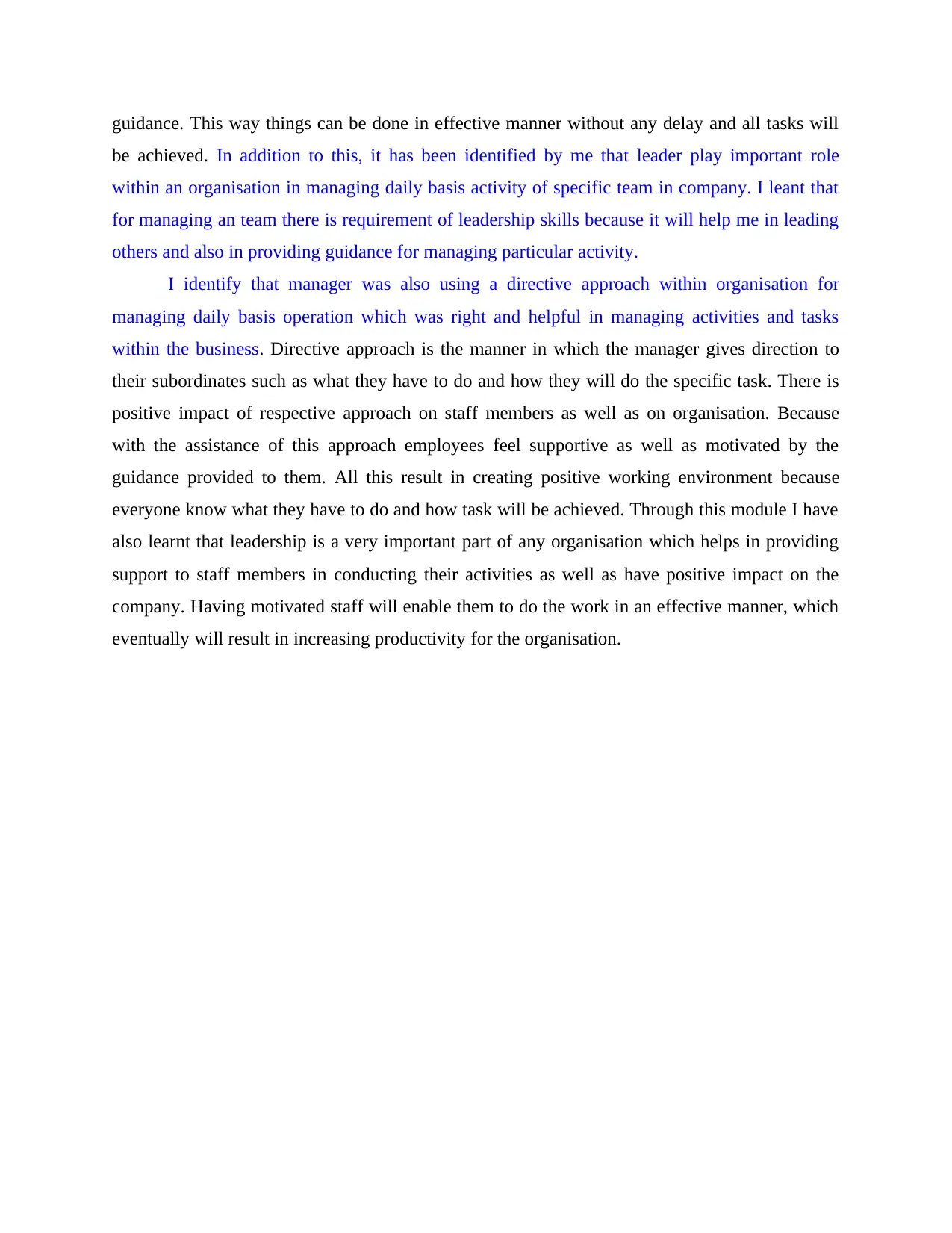
guidance. This way things can be done in effective manner without any delay and all tasks will
be achieved. In addition to this, it has been identified by me that leader play important role
within an organisation in managing daily basis activity of specific team in company. I leant that
for managing an team there is requirement of leadership skills because it will help me in leading
others and also in providing guidance for managing particular activity.
I identify that manager was also using a directive approach within organisation for
managing daily basis operation which was right and helpful in managing activities and tasks
within the business. Directive approach is the manner in which the manager gives direction to
their subordinates such as what they have to do and how they will do the specific task. There is
positive impact of respective approach on staff members as well as on organisation. Because
with the assistance of this approach employees feel supportive as well as motivated by the
guidance provided to them. All this result in creating positive working environment because
everyone know what they have to do and how task will be achieved. Through this module I have
also learnt that leadership is a very important part of any organisation which helps in providing
support to staff members in conducting their activities as well as have positive impact on the
company. Having motivated staff will enable them to do the work in an effective manner, which
eventually will result in increasing productivity for the organisation.
be achieved. In addition to this, it has been identified by me that leader play important role
within an organisation in managing daily basis activity of specific team in company. I leant that
for managing an team there is requirement of leadership skills because it will help me in leading
others and also in providing guidance for managing particular activity.
I identify that manager was also using a directive approach within organisation for
managing daily basis operation which was right and helpful in managing activities and tasks
within the business. Directive approach is the manner in which the manager gives direction to
their subordinates such as what they have to do and how they will do the specific task. There is
positive impact of respective approach on staff members as well as on organisation. Because
with the assistance of this approach employees feel supportive as well as motivated by the
guidance provided to them. All this result in creating positive working environment because
everyone know what they have to do and how task will be achieved. Through this module I have
also learnt that leadership is a very important part of any organisation which helps in providing
support to staff members in conducting their activities as well as have positive impact on the
company. Having motivated staff will enable them to do the work in an effective manner, which
eventually will result in increasing productivity for the organisation.
⊘ This is a preview!⊘
Do you want full access?
Subscribe today to unlock all pages.

Trusted by 1+ million students worldwide
1 out of 13
Related Documents
Your All-in-One AI-Powered Toolkit for Academic Success.
+13062052269
info@desklib.com
Available 24*7 on WhatsApp / Email
![[object Object]](/_next/static/media/star-bottom.7253800d.svg)
Unlock your academic potential
Copyright © 2020–2025 A2Z Services. All Rights Reserved. Developed and managed by ZUCOL.




